The queue for the exhibition Gallipoli, The Scale of Our War, was quiet, even sombre.
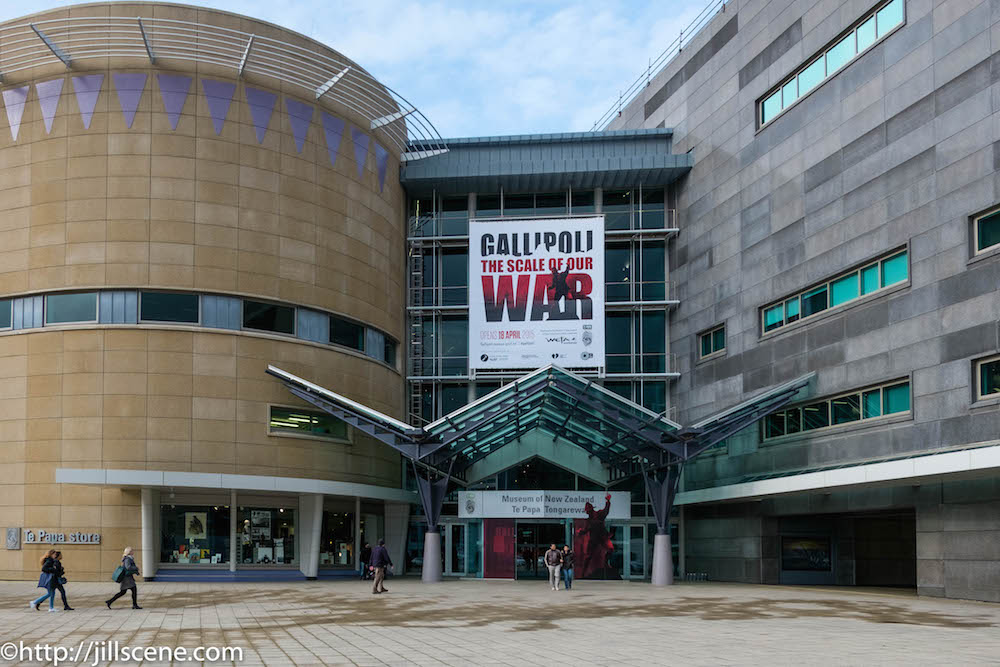
The main entrance to Te Papa, Wellington, New Zealand
People spoke softly, the few children kept close to their parents. The ushers told us we were lucky, we would be admitted within twenty minutes; earlier in the day people had waited for nearly three-quarters of an hour.
The exhibition is grabbing the attention of New Zealanders. It’s been mounted to mark one hundred years since Gallipoli, the campaign in World War One that is often touted as marking the beginning of New Zealand’s nationhood. Back then New Zealand was a dominion of the British Empire. My forebears had only been here fifty or so years. They thought of Britain as home.
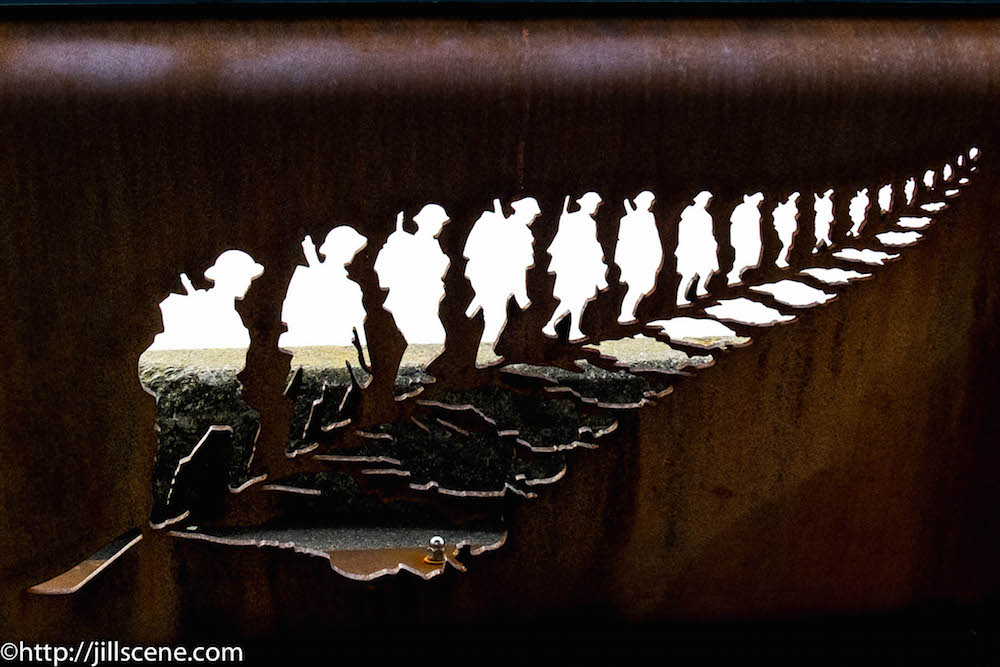
Memorial to departing soldiers, Wellington waterfront.
Gallipoli was an ill-fated campaign for control of the Dardanelles, in Turkey. The British Empire wasn’t the first to come to grief in this part of the world. Just over the brow of the cliffs that tower above ANZAC Cove is the site of the battle of Troy. Without the 20th Century equivalent of a Trojan Horse, our guys were doomed. As one of the veterans said, in typical laconic Kiwi style, “We just couldn’t sort it out.”
The exhibition grabs hold of the viewer. It’s high impact. The super sized models of the soldiers, made by Weta workshop, are impressively detailed, down to flies, beads of sweat, and the pores in their skin.
They make the men (and the one woman – a nurse) appear larger than life. I didn’t like that so much. I think it’s dangerous to idolise this stuff.
But I am interested in how soldiers got through, how they held themselves in tact, and what it took from them to keep on doing what they had to do. How they managed, or not, to hold on to their humanity in the face of such unspeakable brutality. I’m not only referring to the brutality of the foe. (In fact, these two foes, the Turks and the Kiwis, regarded each other with respect.)
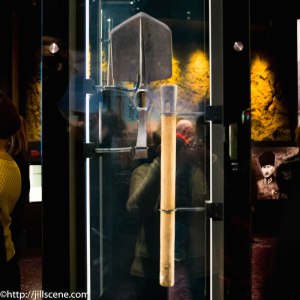
A trowel: Gallipoli, The Scale of Our War.
Take this shovel, for example. It’s not much bigger than a garden trowel. Imagine being ordered to dig a trench with that and we’re not talking garden sized trenches.
Imagine being ordered to scramble up Chunuk Bair, and if you reached the top, to engage in battle, your belly by then empty, every muscle in your body screaming with fatigue.
Or falling asleep on sentry duty on your first day after a bout of pneumonia. A crime so serious the punishment was death by firing squad.
These are the things I wonder about. If you listen to the interviews with veterans, view the photos, and read their letters you’ll get a sense of what the daily reality may have been like.
For me, there was one exhibit that jangled. It was an opportunity to look through a periscope, imitating those used by snipers in the trenches to sight their foe, and to then press a button which simulated the firing of a gun. I did look through the periscope. I didn’t press the button. That was taking matters a bit too far. The veterans I remember from my childhood wouldn’t have been impressed by that. They didn’t talk about the war much but they were highly allergic to anything that trivialised it.
Other exhibits moved me. Dr Fenwick’s expression tells something of the despair and futility he faced. His diary entries are frank about the price paid at Gallipoli. He suggested renaming ANZAC Cove, Bloody Beach Bay.
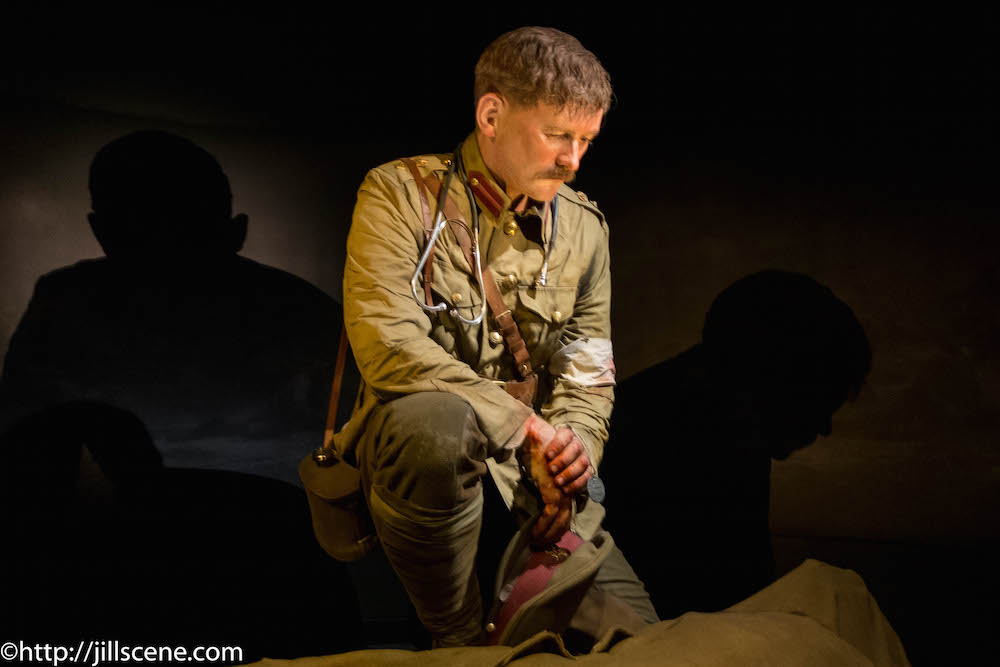
Dr Fenwick: Gallipoli, The Scale of Our War.
Inside Lieutenant Colonel Malone’s hut I had goosebumps. It was exactly one hundred years to the day since Malone wrote a letter to his wife and then left to lead his men up Chunuk Bair. He didn’t make it home.
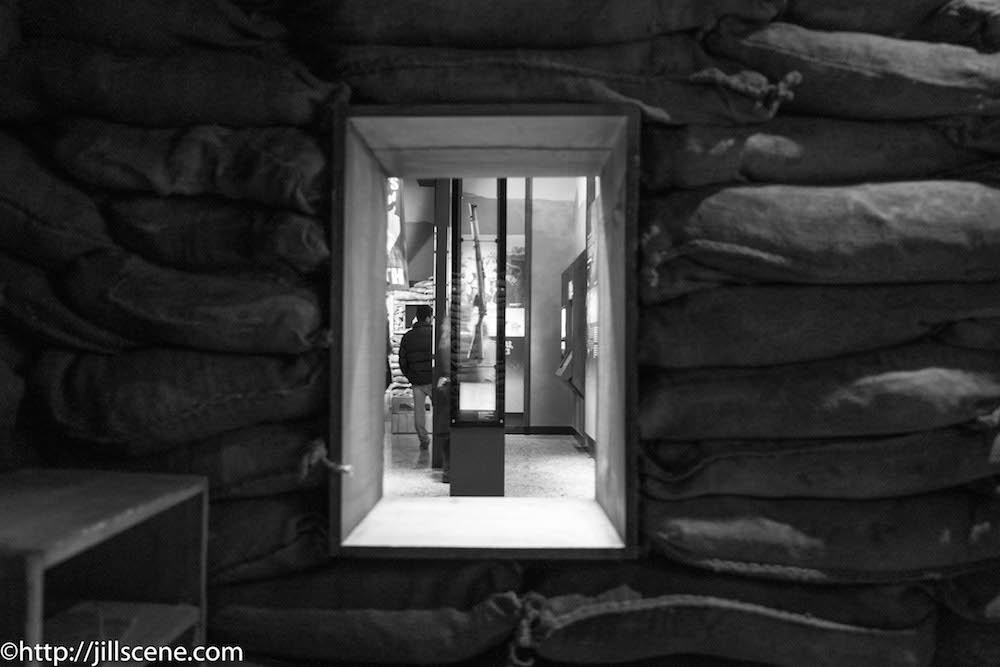
Inside Malone’s hut: Gallipoli, The Scale of Our War
The exhibition is visually impressive. And it’s packed with information. If you go, allow plenty of time, listen to the recorded interviews of veterans, read the excerpts from their diaries, their letters – that’s where you get a sense of what it was like for them.
As to the scale of our war? 93% of New Zealand forces in that campaign were wounded or killed. Ninety-three percent. That figure is staggering, isn’t it. Nevertheless, our total casualties were much higher in the battle of the Somme, in France, the following year.
No wonder the jingoism and the patriotism, which led to more than 14,000 Kiwi men signing up during the first week of war, had worn a bit thin by 1916.
The New Zealand government introduced conscription. Conscientious Objectors, and there were many, paid a high price. Some were imprisoned, others were ridiculed and persecuted, and they had their civil rights removed for ten years. But that’s another story, one not covered in this exhibition.
Categories: Off The Beaten Track in Aotearoa


Well written it not only takes us to the exhibit, it takes us to the war. The Caen Peace Museum does the same thing for WWII and the Invasion of Normandy. It show actual footage of both American and German film of the same place at the same time on a giant sized screen.
How we can see these things and still be dragged into wars is beyond me.
LikeLike
That would be a fascinating exhibit, Eileen. I have visited Arromanches, it was very haunting. I’m with you, about war. I suppose the thirst for power is just too difficult to resist.
LikeLike
This is incredibly moving and well done.Gives me goosebumps. We will be in Gallipoli next year.
LikeLike
Thanks Cindy, How wonderful to go to Gallipoli. Our son was there a few months ago … he told me about the proximity to Troy.
LikeLike
Fantastic post…such a testament as to the illogical and sad conditions war brings to the population. I am renting the movie tonight, have heard so much about it ~
LikeLike
Thanks so much for visiting and commenting, Dalo. What did you think of the movie?
LikeLike
Loved the movie ~ great acting, but also the heroic action and people as well as the tragedy of war (especially friendships). Excellent movie!
LikeLike
A very compassionate post about a devastating part of New Zealand’s history. It is a story that needs to be told in graphic detail, no glorifying it. As you mentioned the jingoism lulled so many into thinking it would be a grand adventure how sadly they paid the price.
LikeLike
A truly terrible price, Pauline. It was fascinating listening to the interviews with the veterans. They told it like I imagine it might actually have been. It was in the tone of their voices, as much as anything.
LikeLike
A terrible time, we have been lucky not to have our children involved in a major war. (of course there has been all the conflict in the middle east but that is not on our doorstep)
LikeLiked by 1 person
I truly appreciate your historical posts not only because I’m learning more about your country but also because it gives us the opportunity to compare and contrast with modern times wars, and reflect about it. Sadly it confirms that the human race learns nothing from history and keeps repeating it.
Thanks for a most interesting post.
LikeLike
Sadly, we do keep repeating the lessons. Perhaps each generation has to find them out for themselves. Thanks so much for your encouragement, Lucile.
LikeLike
Thank you again, for an insightful post.
LikeLiked by 1 person
I agree with your feelings about idolizing war. Yet the sacrifices these people made are undeniable and almost incomprehensible…it seems the old men are always ready to send the young men into battle. Sad.
LikeLike
Huge respect to those who signed up and sacrificed their lives, eh. But I must admit if I’d been given one of those shovels and told to dig a trench with it, I’d have felt hugely let down. Hmmm, maybe people thought differently then, less individualistically.
LikeLike
A humanistic view of men in hell. Bravo, dear Jill!
LikeLike
Thank-you Fabio. Hell is the best word for it.
LikeLiked by 1 person
Thanks much, Jill! I had a chance to visit the museum two years ago. It is an important cultural hub in Wellington. Take care and enjoy your beautiful country! 🙂
LikeLiked by 1 person
As I read your account, a feeling of great sadness came over me. How awful it must have been for those caught up in this tragic event.
LikeLike
Hello Sylvia, Thahk-you for reading and commenting. You are right, it must have been terrible for those caught up in it, including those left behind. Overall, I think the exhibition handled the subject matter very well.
LikeLiked by 1 person
Very sobering post, Jill
LikeLike
It’s a very sad part of our history, Sue.
LikeLiked by 1 person
Indeed. My Grandfather was there, and everyone said he wasn’t the same man when he returned…. We now know why.
LikeLike
Thank you for sharing your visit and your thoughts, Jill. I have such mixed feelings when visiting War Memorials, Holocaust, Civil War, Revolutionary War and POW sites. In a perfect world where tribes/cultures don’t clash, countries don’t conquer and oppress, and evil individuals don’t exist, we could achieve the ideals of co-existence we so dearly cherish. There is nothing glorious about war. And I have no answers that will keep history from repeating itself.
LikeLike
Me neither, Sammy D. I like to think if we just talked more and kept talking until we got to some sort of understanding, that would do it … but it requires good will on all sides.
LikeLiked by 1 person
I know so very, very little about NZ history — I didn’t even know Gallipoli played a part for Kiwi independence. It makes perfect sense, though, after having read this. (I got chills, too… You did a good job 🙂 ) I admire the people and the institutions that put together these exhibitions on such difficult subjects; these things need to be not just remembered but seen from as many angles as possible in order to understand them — and, just maybe, prevent them from happening again.
Great post. Thank you.
LikeLike
Hi there Guilie, A lot of research and planning has gone into this exhibition and it shows. Entry is free, too. Te Papa wants the exhibition to be accessible to all New Zealanders. Thank-you for reading and for telling me about the chills!
LikeLike
93%. Makes the heart heavy indeed.
LikeLike
Yes, it does, Carrie, so much heart break.
LikeLiked by 1 person
I always enjoy exhibits like this (history nut). They reveal so much about the conditions these brave soldiers lived and fought and too often died in. It is sad that more people can’t visit exhibits like this and be reminded of why we don’t need to go to war to solve global or local problems. Our world has been shaped by too many wars. Some gains have been made but the prices has been so high. I like your line about not pressing the button. Thanks for showing them that amount of respect.
LikeLike
It was the war to end all wars, or so they said about WW1. There was no way I was pushing that button, the ghosts of those men were shouting in my ear!
LikeLiked by 1 person
Pleased to read your account of the exhibition. Today 15 August is the day my great uncle died a hundred years ago after being wounded on 8 August in the Gallipoli campaign . He was with the Wellington Battalion. His suffering must have been horrendous. Wounded on the 8th, finally put on the hospital ship on 12th, then dead before the ship reached Alexandria. He is much on our minds today. By the way I am very happy to see the memorial to the departing soldiers; that’s new to me.
LikeLike
Hello Gallivanta, I think the Wellington Battalion was in the thick of it on Chunuk Bair on the 8th of August. The memorial to the departing soldiers is on the wharf just behind Te Papa, near where 8,500 men boarded troop ships in October 1914. In our family we have the first of the 100 year anniversaries next year. Commiserations to you.
LikeLiked by 1 person
I haven’t been to Wellington since 2002 so I think it’s time to make another visit. 🙂
LikeLiked by 1 person
It’s sad that war is still happening, all this suffering is still happening all over he world, although now it is “modern”. Will humanity ever learn?
LikeLike
I reckon Peter, Paul, and Mary sang it best, Claudette: “Oh, when will they ever learn, Oh, when will they ever learn.
LikeLiked by 1 person
Very true, Jill.
LikeLiked by 1 person